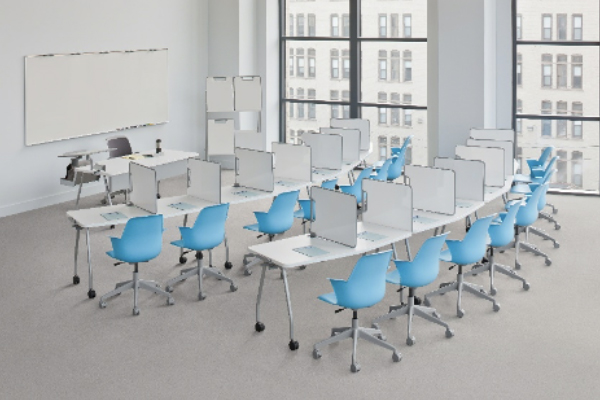Why Educational Design Will Matter After the COVID-19 Pandemic
Article | 05.12.2020By Casey Bourdo, Senior Interior Designer, Wightman
As a mother of three school-aged children, the health, safety, and well-being of my kids when they are not in my sight is of number one priority. Two months ago, if you would have suggested to me that my children’s daily educational delivery would have changed as drastically as it has, I would have seriously questioned your sanity; now I question my own sanity. Let me be clear; this is not hyperbole here. Two months ago, my children went to school every day, attended physical education classes, and played with their peers during recess. Now everything has changed, including what the future educational spaces will look like when my children go back to school next year.
As we sit here looking ahead to when school goes back into session in the fall and our children return to the physical environment of school, many thoughts and questions are coming to light. Thoughts about how we can best support our children in a healthy learning environment. Although it may be a lot of speculation right now, it could mean drastic changes to the familiarity of the typical school day as we (designers, parents, teachers and our children) know it.
When I think of my own kids’ schooldays, I picture shared classroom tables, shared cubbies and lockers, hundreds of little hands on playground equipment and gym toys, and shoulder to shoulder contact in hallways and lunchrooms. When the COVID-19 pandemic struck, the number one response we all heard to help prevent the spread and slow the curve was the term social distancing, maintaining a minimum of six feet from our peers.
As an Interior Designer who works in educational design, what exactly does social distancing mean for school classrooms of 900 sq. ft. and 20+ kids, common areas with shared soft seating, computer labs with shared technology, libraries with lounge seating, and the overall walkability of our children getting to and from one room to another? As of right now, it is a lot of uncertainty, but one thing we do know is that change will happen and social distancing, in some measure, will more than likely be implemented. For some schools and classrooms, especially those that may have more recently undergone a renovation, the change might not be as severe but when you picture the traditional school with older classrooms and outdated furniture and equipment, it could mean exploring a multitude of options to adhere to the social distancing guidelines, guidelines in which a properly designed interior environment will be of elevated importance.
The COVID-19 pandemic forced many of us, including myself, to become extraordinarily flexible in our day-to-day schedules. It forced schools and educators to implement innovative solutions, practically overnight, to keep our children engaged while learning remotely. It challenged many of us in ways we were not prepared for, but with each challenge also comes opportunity; the opportunity for innovation to rise to the fore front. We will begin to see innovation in much more than just virtual learning, it will become the new norm in classroom layouts and space plans, separation in common areas, programming and circulation plans that include physical distance measures and furniture arrangements to allow for more personal space while continuing to support a sense of unity and camaraderie. As other areas in the world are beginning to implement new ideas and best practice recommendations in educational design and safety, these areas are starting to become noticeable and we have begun to see adjustments in areas such as:
- Dividers and sneeze guards strategically placed around students while learning or eating lunch.
- Interior finish recommendations that support a healthy environment such as antimicrobial and easily cleanable surfaces and finishes.
- Sanitizing stations for hands and shoes at entrances and throughout the schools to promote cleanliness.
- Encouraging physical distancing in classroom settings and hallways.
- Removing doors or implementing copper or brass door hardware which are naturally antimicrobial.
- Scanning student and staff thermal temperatures prior to entering the school.
- Air quality recommendations such as opening windows or installing ventilating systems to remove potentially contaminated air.
- Implementing face masks in high density areas or gatherings.
Although it may be too early to fully understand the impacts that COVID-19 will have on educational design, there are signs suggesting that it could have a long term influence on learning as we know it – and that means a change for students, a change for parents, a change for educators, and a change for those of us who work to plan and design these educational facilities for children to learn and grow, feel safe, and maybe right now, most importantly, remain healthy.
Services
